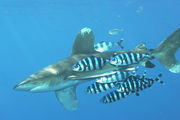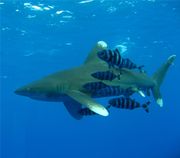Oceanic whitetip shark
| Oceanic whitetip shark | |
|---|---|
 |
|
| Conservation status | |
|
Vulnerable (IUCN 3.1) |
|
| Scientific classification | |
| Kingdom: | Animalia |
| Phylum: | Chordata |
| Class: | Chondrichthyes |
| Subclass: | Elasmobranchii |
| Order: | Carcharhiniformes |
| Family: | Carcharhinidae |
| Genus: | Carcharhinus |
| Species: | C. longimanus |
| Binomial name | |
| Carcharhinus longimanus (Poey, 1861) |
|
 |
|
| Range of oceanic whitetip shark | |
| Synonyms | |
|
Squalus maou, Lesson 1822-1825 Squalus longimanus, Poey 1861 Pterolamiops longimanus Carcharhinus obtusus, Garman 1881 Carcharhinus insularum, Snyder 1904 Pterolamiops magnipinnis, Smith 1958 Pterolamiops budkeri, Fourmanoir 1961 |
|
The oceanic whitetip shark, Carcharhinus longimanus, is a large pelagic shark inhabiting tropical and warm temperate seas. Its stocky body is most notable for its long, white-tipped, rounded fins.
This aggressive but slow-moving fish dominates feeding frenzies, and is a danger to shipwreck or air crash survivors.[1] Recent studies[2][3] show steeply declining populations because its large fins are highly valued as the chief ingredient of shark fin soup and, as with other shark species, the whitetip faces mounting fishing pressure throughout its range.
Contents |
Taxonomy
The oceanic whitetip shark was first described by naturalist René-Primevère Lesson in his account of Louis Duperrey's 1822–1825 world-circling journey on the corvette Coquille. Lesson described two specimens found in the Tuamotu Archipelago in French Polynesia, and named the shark Squalus maou after a Polynesian word for "shark". However, Lesson's description and name were forgotten.[4]
It was next described by Cuban Felipe Poey in 1861 as Squalus longimanus.[4] The name Pterolamiops longimanus has also been used. The species epithet, longimanus, refers to the size of its pectoral fins (longimanus translates from Latin as "long hands").[5] The oceanic whitetip shark has many common names in English: Brown Milbert's sand bar shark, brown shark, nigano shark, whitetip whaler, and whitetip shark.[5]
The rules of the International Commission on Zoological Nomenclature are that in general the first-published description has priority; therefore the valid scientific name for the oceanic whitetip shark should be Carcharhinus maou. However, Lesson's name remained forgotten for so long that Carcharhinus longimanus, which means long-hands, remains widely accepted.[6]
Distribution and habitat
The oceanic whitetip is found globally in deep, open water, with a temperature greater than 18 °C (64 °F).[7] It prefers waters between 20 °C (68 °F) and 28 °C (82 °F) and tends to withdraw from areas when temperatures fall below this.[6] They were once extremely common and widely distributed, and still inhabit a wide band around the globe; however, recent studies suggest that their numbers have drastically declined.[2] An analysis of the US pelagic longline logbook data between 1992–2000 (covering the Northwest and Western Central Atlantic) estimated a decline of 70% over that period.[3]
They are found worldwide between 45° north and 43° south latitude.[4][7] In 2004, an oceanic whitetip was discovered dead on the west coast of Sweden—far beyond what was once considered the northern boundary of its range.[8]
The shark spends most of its time in the upper layer of the ocean—to a depth of 150 metres (490 ft)[7]—and prefers off-shore, deep-ocean areas. According to longline capture data, increasing distance from land correlates to a greater population of sharks.[5] Occasionally it is found close to land, in waters as shallow as 37 metres (120 ft), mainly around mid-ocean islands such as Hawaii, or in areas where the continental shelf is narrow and there is access to nearby deep water. It is typically solitary, though gatherings have been observed where food is plentiful.[6] Unlike many animals, it does not have a diurnal cycle, and is active both day and night.[5] Its swimming style is slow, with widely spread pectoral fins . Despite their habitual isolation from members of their own species, pilot fish, dolphinfish, and remora may accompany them.[5] In 1988, Jeremy Stafford-Deitsch reported seeing an individual accompanied by a shortfin pilot whale.[9]
Anatomy and appearance

C. longimanus' most distinguishing characteristics are its long, wing-like pectoral and dorsal fins. The fins are significantly larger than most other shark species, and are conspicuously rounded. The shark's nose is rounded and its eyes are circular, with nictitating membranes.[5]
C. longimanus has a 'typical', although somewhat flattened requiem shark body, often with a mildly humpbacked aspect. It is bronze, brown, bluish or grey dorsally (the color varies by region), and white ventrally (although it may occasionally have a yellow tint). Its maximum size is 4 metres (13 ft), although usually it does not exceed 3 metres (10 ft). Its maximum reported weight is 170 kilograms (370 lb). The female is typically larger than the male by 10 centimetres (4 in) with males about 1.8 metres (71 in) and females about 1.9 metres (75 in).[5][6]
Most of its fins (dorsal, pectoral, pelvic, and caudal) have white tips (juvenile specimens and some adults may lack these). Along with white tips, the fins may be mottled—and in young specimens can have black marks. A saddle-like marking may be apparent between first and second dorsal fins.[5] The shark has several kinds of teeth—those in the mandible (lower jaw) have a thin serrated tip and are relatively small and triangular (somewhat fang-like). There are between 13 and 15 teeth on either side of the symphysis. The teeth in the upper jaw are triangular, but much larger and broader with entirely serrated edges—there are 14 or 15 along each side of the symphysis.[5] The denticles lie flat and typically have between five and seven ridges.[5]
Diet
C. longimanus feeds mainly on pelagic cephalopods and bony fish.[7] However, its diet can be far more varied and less selective—it is known to eat threadfins, stingrays, sea turtles, birds, gastropods, crustaceans, mammalian carrion, and even rubbish dumped from ships. The bony fish it feeds on include lancetfish, oarfish, barracuda, jacks, dolphinfish, marlin, tuna, and mackerel. Its feeding methods include biting into groups of fish and swimming through schools of tuna with an open mouth. When feeding with other species, it becomes aggressive.[6] Peter Benchley, author of Jaws, observed this shark swimming among pilot whales and eating their feces.[10]
Behavior

The oceanic whitetip is usually solitary and slow-moving, and tends to cruise near the top of the water column, covering vast stretches of empty water scanning for possible food sources.[5] Until the 16th century,[11] sharks were known to mariners as 'sea dogs'[12] and the oceanic whitetip, the most common ship-following shark,[6] exhibits dog-like behavior when its interest is piqued: when attracted to something that appears to be food, its movements become more avid and it will approach cautiously but stubbornly, retreating and maintaining a safe distance if driven off, but ready to rush in if the opportunity presents itself. Oceanic whitetips are not fast swimmers, but they are capable of surprising bursts of speed. Whitetips commonly compete for food with silky sharks, making up for its comparatively leisurely swimming style with aggressive displays.[6]
Groups often form when individuals converge on a food source, whereupon a "feeding frenzy" may occur. This seems to be triggered not by blood in the water or by bloodlust, but by the species' highly strung and goal-directed nature (conserving energy between infrequent feeding opportunities when it is not slowly plying the open ocean). The oceanic whitetip is a competitive, opportunistic predator that exploits the resource at hand, rather than avoiding trouble in favor of a possibly easier future meal.[6]
There does not seem to be segregation by sex and size. Whitetips follow schools of tuna or squid, and trail groups of cetaceans such as dolphins and pilot whales, scavenging their prey. Their instinct to follow is so strongly imprinted, from countless millennia following baitfish migrations, that they accompany ocean-going ships. When whaling took place in warm waters, oceanic whitetips were often responsible for much of the damage to floating carcasses.[6]
Reproduction
Mating season is in early summer in the northwest Atlantic Ocean and southwest Indian Ocean, although females captured in the Pacific have been found with embryos year round, suggesting a longer mating season there.[6] The shark is viviparous—embryos develop in utero and are fed by a placental sac. Its gestation period is one year. Litter sizes vary from one to 15 with the young born at a length of about 0.6 metres (24 in).[3] Sexual maturity is reached at close to 1.75 metres (69 in) for males and 2 metres (80 in) for females.[3]
Relation to humans

It is a commercially important species for its fins, its meat and oil. It is eaten fresh, smoked, dried and salted and its hide is used for leather.[6] It is subject to fishing pressure throughout virtually its whole range[3]—although it is more often taken as by-catch than by design, since it is drawn to longline bait that is intended for other species.[6]
Famed oceanographic researcher Jacques Cousteau described the oceanic whitetip as "the most dangerous of all sharks".[13] Despite the greater notoriety of the great white shark and other sharks habitually found nearer the shore, the oceanic whitetip is responsible for more fatal attacks on humans than all other species combined, as a result of predation on survivors of shipwrecks or downed aircraft.[1][14] Such incidents are not included in common shark-attack indices for the 20th and 21st centuries, and as a result of this, the oceanic whitetip does not have the highest number of recorded incidents.[15] [16] Nonetheless, incidents involving the oceanic whitetip total in the thousands worldwide,[16] with one incident alone, the torpedoing of USS Indianapolis on 30 July 1945, accounting for 600 to 800 sailors.[14] Tiger sharks may have been responsible for some deaths.
Also during World War II, the Nova Scotia, a steamship carrying approximately 1,000 people near South Africa, was sunk by a German submarine. With only 192 survivors, many deaths were attributed to the whitetip.[1]
The whitetip poses a minimal threat to bathers or inshore sportsman, but a high risk for humans caught in the open ocean.
Although the whitetip is opportunistic and aggressive, and may attack humans for food,[14] divers have swum with this shark repeatedly without incident. Divers are advised to approach the shark only with extreme caution, to not spear fish near this shark and, if the shark comes too close or gets too inquisitive, to get out of the water as soon as possible.
Conservation status
In 1969, Lineaweaver and Backus wrote of the oceanic whitetip: "[it is] extraordinarily abundant, perhaps the most abundant large animal, large being over 100 pounds [45 kg], on the face of the earth".[17] There was little further population study until 2003 when the numbers were estimated to have dropped by as much as 70% in the Northwest and Western Central Atlantic between 1992–2000.[3] Another study focusing on the Gulf of Mexico, using a mix of data from US pelagic longline surveys from the mid-1950s and observations from the late-1990s, estimated a decline in numbers in this location of 99.3% over this period.[2] However, changes in fishing practices and data collection methods complicate estimates.[18]
As a result of these findings its status on the IUCN Red List was moved to "Vulnerable" globally (from "Lower Risk/Near Threatened") and "Critically Endangered" in the Northwest and Western Central Atlantic areas.[3]
Under the 1995 UN Agreement on the Conservation and Management of Straddling Fish Stocks and Highly Migratory Fish Stocks (UNFSA), coastal and fishing states are specifically required to adopt measures to conserve listed species, but little progress is visible on the oceanic whitetip.[3]
See also
- List of sharks
- Outline of sharks
- Shark attack
References
- ↑ 1.0 1.1 1.2 Bass, A.J., J.D. D'Aubrey & N. Kistnasamy. 1973. "Sharks of the east coast of southern Africa. 1. The genus Carcharhinus (Carcharhinidae)." Invest. Rep. Oceanogr. Res. Inst., Durban, no. 33, 168 pp.
- ↑ 2.0 2.1 2.2 Baum, J.K. and Myers, R.A. 2004. Shifting baselines and the decline of pelagic sharks in the Gulf of Mexico. Ecology Letters. 7(3): 135–45.
- ↑ 3.0 3.1 3.2 3.3 3.4 3.5 3.6 3.7 IUCN. "IUCN Red List of Threatened Species: Carcharhinus longimanus". http://www.iucnredlist.org/search/details.php/39374/all. Retrieved 18 July 2006.
- ↑ 4.0 4.1 4.2 ITIS. "Integrated Taxonomic Information System: Carcharhinus longimanus". http://www.itis.gov/servlet/SingleRpt/SingleRpt?search_topic=TSN&search_value=160330. Retrieved 18 August 2008.
- ↑ 5.00 5.01 5.02 5.03 5.04 5.05 5.06 5.07 5.08 5.09 5.10 Cathleen Bester. "Oceanic Whitetip Shark". Florida Museum of Natural history. http://www.flmnh.ufl.edu/fish/Gallery/Descript/OceanicWT/OceanicWT.html. Retrieved 22 July 2006.
- ↑ 6.00 6.01 6.02 6.03 6.04 6.05 6.06 6.07 6.08 6.09 6.10 6.11 Leonard J. V. Compagno (1984). Sharks of the World: An annotated and illustrated catalogue of shark species known to date. Food and Agriculture Organization of the United Nations. pp. 484–86, 555–61, 588.
- ↑ 7.0 7.1 7.2 7.3 Ed. Ranier Froese and Daniel Pauly. "Carcharhinus longimanus". FishBase. http://www.fishbase.org/Summary/SpeciesSummary.php?id=875. Retrieved 6 February 2006.
- ↑ Eli. "Fishwatcher". Fishwatcher. http://64.95.130.5/FishWatcher/Record.cfm?autoctr=650. Retrieved 6 February 2006.
- ↑ Stafford-Deitsch, Jeremy (1988). Shark: A Photographer's Story. Sierra Club Books.
- ↑ Benchley, Peter (2002). Shark Trouble. Random House.
- ↑ "Online Etymology Dictionary". http://www.etymonline.com/index.php?search=shark&searchmode=none. Retrieved 2006-08-08.
- ↑ RF Marx (1990). The History of Underwater Exploration. Courier Dover Publications. p. 3.
- ↑ Cousteau, Jacques-Yves & Cousteau, Philippe (1970). The Shark: Splendid Savage of the Sea. Doubleday & Company, Inc.
- ↑ 14.0 14.1 14.2 Martin, R. Aidan.. "Elasmo Research". ReefQuest. http://www.elasmo-research.org/education/shark_profiles/carcharhinidae.htm. Retrieved 6 February 2006.
- ↑ "ISAF Statistics on Attacking Species of Shark". Flmnh.ufl.edu. 2009-05-20. http://www.flmnh.ufl.edu/fish/sharks/statistics/species2.htm. Retrieved 2010-07-05.
- ↑ 16.0 16.1 "Oceanic Whitetip". howstuffworks.com. http://animals.howstuffworks.com/fish/most-dangerous-shark2.htm.
- ↑ Thomas H. Lineaweaver III and Richard H. Backus (1969). The Natural History of Sharks. Lippincourt.
- ↑ Baum, J.K., Kehler, D. and Myers, R.A. 2005. Robust estimates of decline for pelagic shark populations in the northwest Atlantic and Gulf of Mexico. Fisheries 30: 27–30.
- General references
- Baum et al. (2005). Carcharhinus longimanus. 2006. IUCN Red List of Threatened Species. IUCN 2006. www.iucnredlist.org. Retrieved on 11 May 2006. Database entry includes a lengthy justification of why this species is vulnerable
- Leonard J. V. Compagno, Sharks of the Order Carcharhiniformes, Princeton University Press, 1988, ISBN 0-691-08453-X
- Leonard J. V. Compagno, Sharks of the World: An annotated and illustrated catalogue of shark species known to date, Food and Agriculture Organization of the United Nations, 1984
- Leonard J. V. Compagno, FAO Species Catalogue, Vol. 4, Parts 1 and 2, Sharks of the World, 1984, Rome: FAO
- William N. Eschmeyer, Special Publication of the Center for Biodiversity Research and Information, no. 1, vol 1–3, California Academy of Sciences, 1998, ISBN 0940228475
- Richard H. Backus, Stewart Springer and Edgar L. Arnold, Jr. A contribution to the natural history of the white-tip shark, Pterolamiops longimanus (Poey), 1956, Deep-Sea Research vol. 3
- A. J. Bass, J. D. D'Aubrey and N. Kistnasamy, Sharks of the east coast of southern Africa. 1. The genus Carcharhinus (Carcharhinidae), 1973, Oceanographic Research Institute, Durban
- Richard Ellis, The Book of Sharks, 1976, New York: Grosset & Dunlap
- Reader's Digest, Sharks: Silent Hunters of the Deep, 1989, Sydney: Reader's Digest
- Jeremy Stafford-Deitsch, Shark: A Photographer's Story, 1988, San Francisco: Sierra Club Books
- Froese, Rainer, and Daniel Pauly, eds. (2005). "Carcharhinus longimanus" in FishBase. 09 2005 version.
- "Carcharhinus longimanus". Integrated Taxonomic Information System. http://www.itis.gov/servlet/SingleRpt/SingleRpt?search_topic=TSN&search_value=160330. Retrieved 16 November 2005.
- Oceanic whitetip shark (Carcharhinus longimanus) at Wikimedia Commons
- Oceanic whitetip shark (Carcharhinus longimanus) at Wikispecies
- Oceanic whitetip shark (Carcharhinus longimanus) at Integrated Taxonomic Information System
- Oceanic whitetip shark (Carcharhinus longimanus) at Encyclopedia of Life
- Oceanic whitetip shark (Carcharhinus longimanus) at IUCN Red List
- Oceanic whitetip shark (Carcharhinus longimanus) at BioLib
- Oceanic whitetip shark (Carcharhinus longimanus) at Global Biodiversity Information Facility
- Oceanic whitetip shark (Carcharhinus longimanus) at Animal Diversity Web
- Oceanic whitetip shark (Carcharhinus longimanus) at FishBol
- Oceanic whitetip shark (Carcharhinus longimanus) at FishBase
- Oceanic whitetip shark (Carcharhinus longimanus) at Ocean Biogeographic Information System
External links
- Introducing an ongoing study of the Oceanic Whitetip Shark in the Red Sea
- ARKive - images & movies of the oceanic whitetip shark
- Oceanic Whitetip shark Carcharhinus longimanus MarineBio"
- Whitetip Oceanic Shark profile, Florida Museum of Natural History.
- Biology and Behaviour of the Oceanic Whitetip
- Oceanic Whitetip footage in the Red Sea by Brian Eastwood.
|
|||||||||||||||||||||||||||||||||||||||||||||||||||||||||||||||||||||||||||||||||||||||||||||||||||||||||||||||||||||||||||||||||||||||||||||||||||||||||||||||||||||||||||||||||||||||||||||||||||||||||||||||||||||||||||||||||||||||||||||||||||||||||||||||||||||||||||||||||||||||||||||||||||||||||||||||||||||||||||||||||||||||||||||||||||||||||||||||||||||||||||||||||||||||||||||||||||||||||||||||||||||||||||||||||||||||||||||||||||||||||||||||||||||||||||||||